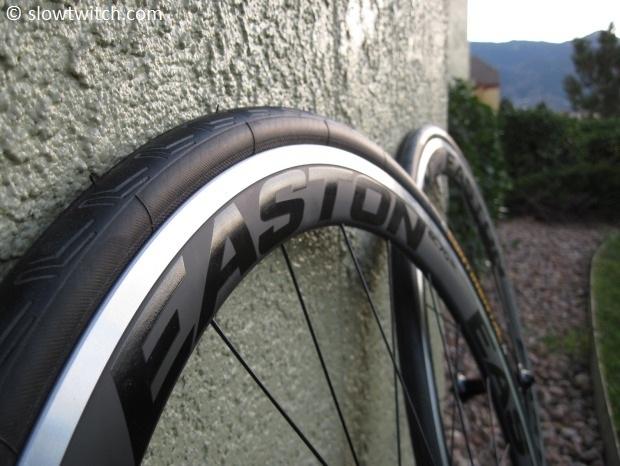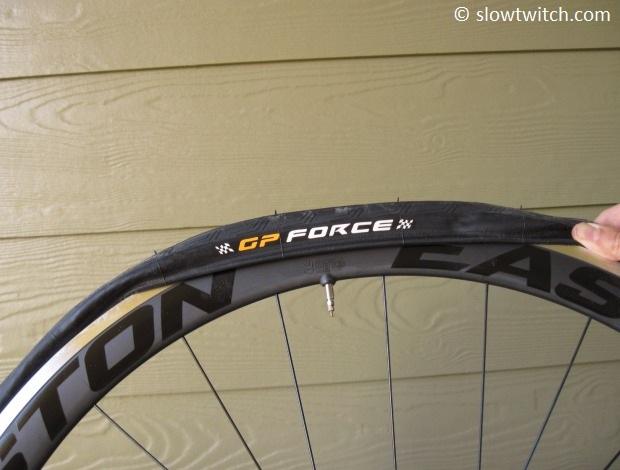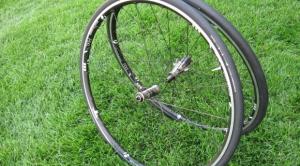Many of you are familiar with products from Easton. Products other than bicycle parts. Easton is known more for their baseball, softball, hockey, and lacrosse equipment, than anything you could find on a bike.
The bicycle division is known as Easton-Bell Sports. Their retail brands include Easton Cycling, Bell, Giro, Blackburn, and Riddell. Many cyclists and triathletes I talk to have no idea that Easton – the cycling side of Easton – is really just a small part of a much larger whole. As well, many find it shocking that two of the largest helmet brands (Giro and Bell) are actually the same company.
All of this back-end information is neither here nor there. I don’t intend to draw conclusions from it; only inform those who didn’t know. The fact that Easton is so large could be a good thing. It means there is (potentially) more R&D money, more engineering resource, and a longer-term view of company growth than a smaller manufacturer. But – it could also be bad. Large companies can breed bureaucracy, red tape, and ‘product line tunnel vision’ (I’ll go ahead and copyright that phrase right now).
This in mind, I was quite excited to spend some quality time with Easton’s new EC70 SL clincher, to make my own judgment on the product. It’d been a long time since I’d ridden any wheels from Easton, so we had some major catching up to do.
Out-of-the-box, the wheels sure look striking with their black-on-black graphics.

My test kit included front and rear wheels, rim tape, and steel quick release skewers. Note that valve extenders were not included. You can either use another brand of extender, or use long valve (60mm) inner tubes, as I did.
I wanted to learn a few key things about these wheels:
1. What is the design intent? Who is the target customer?
2. What’s the aero story? Are they fast?
3. How do they hold up mechanically?
4. Are they a good value?
Let’s see what we can find out.
Design Details
Given that Easton has full-carbon clincher rims in other wheels, I wondered why they decided to debut a new hybrid-style rim.
What’s a hybrid rim? The bulk of the rim’s ‘depth’ is made of carbon fiber. This gets mated to an aluminum extrusion that serves as the tire’s connection point and the braking surface. In the case of these EC70 SL’s, the carbon portion is a structural part of the wheel; the spokes anchor directly to it. This is similar in design to the Zipp carbon/aluminum clinchers, or Shimano’s Dura Ace clincher wheels. Some other competing wheels use a non-structural design where the spokes pass through the carbon and anchor to the aluminum hoop (including Bontrager’s Aura 5, Hed’s Jet series, or the Mavic Cosmic Carbone). Both designs have their strengths and weaknesses, and one doesn’t necessarily take all the cake.
You can clearly see that the buck stops here (and the spoke does, too):

According to Easton, the reasoning behind this hybrid design is a simple one: Aluminum still wins the braking war, especially in wet conditions. Some people want the look, aerodynamics, and cache of carbon – but with the reliable braking and durability of an aluminum outer hoop. I consider myself among that set of customers. While carbon clinchers look better, I still do prefer the great braking and general simplicity of alloy rims.
The other similarity I found between the EC70 SL and the Zipp hybrid clincher rims was tire fit. In two words – they’re tight.

That’s a Continental Attack/Force combo, which I will review separately. Try as I might, I could not install the tires without using tools. This isn’t a deal-breaker for me personally, but ought to be considered by smaller female triathletes or anyone who lacks experience changing inner tubes. The tires fit tightly because the aluminum extrusion used is ‘H-shaped’. Rather than have a deep channel between the clincher bead hooks, the rim floor is flat (which aids in bonding the carbon and aluminum portions together). Traditional aluminum wheels and most non-structural hybrid rims have a curved floor, which reduces the effective diameter of the middle of the rim, aiding in tire installation.
Price is also a consideration that likely led to the hybrid construction. These EC70 SL wheels retail for $1,500 per pair; substantially less than the $2,100 asking price of the EC90 Aero 56mm carbon clinchers. Also compare this to $1,550 for a set of Hed Jet 5 Express wheels, or $1,400 for Bontrager’s Aura 5; clearly Easton had these competitors in their sights.
This information answered my first question. If I’m hearing Easton right, these wheels are for budget-conscious athletes who want a reliable, do-it-all carbon wheel with an aluminum brake track. Easy enough.
Aerodynamics
Some of you probably skipped right to this section. “If it ain’t aero, I ain’t interested.” Surely this is of paramount concern to many triathletes looking for that Kona slot or top step on the podium. I was eager to dive in to the nitty-gritty details of drag numbers and yaw angles.
Unfortunately, this is one area in which I was unable to get any hard data. The Easton representatives simply told me that aerodynamic information is not available at this time. While I understand the position of holding your cards close to your chest, the devil’s advocate in me has (lots of) questions. What do Easton’s own test results show? Did they use wind tunnel testing or CFD during the design process? What do independent tests say about this wheel? Unfortunately, I have no idea.

On paper, the wheels look what I’d call ‘reasonably aerodynamic’. They sit at 42mm of rim depth, which is certainly faster than a box-section training wheel. They have 18 spokes front and 24 rear – although they are round spokes, not bladed or elliptical. My Vernier calipers confirmed their published rim width of 20.0mm – so these wheels do not follow the recent trend of wider-is-better. At first glance, the wheels really reminded me of the now-discontinued 44mm deep Zipp 303 carbon/aluminum clincher wheel (which isn’t necessarily a bad thing). I’d venture a guess that the two wheels perform in the same aerodynamic ballpark.
Easton did publish a promotional YouTube video about these wheels, in which they make some aerodynamic claims. They say that aerodynamics are achieved via the 42mm deep rim and internal spoke nipples. While I won’t argue the point, it sounds vague, if you ask me. They go on to say that they are, “unbeatable on the flats, unbeatable in a breakaway, and fantastic for triathlons”. This had me curious – are they suggesting that the wheels are more aerodynamic than the 56mm carbon clincher EC90, and the 90mm tubular EC90 TT? We know our readers well – enough to know that they need hard numbers to believe performance claims.
My opinion on the ‘speed’ of these wheels is this: They’ll get you around. They’ll get the job done – likely at a faster speed than your tank-like training wheels. If you don’t want to have two sets of wheels (one racing, one training), these are not a bad choice at all, especially for the price. However – they are not as aerodynamic as the new breed of wide and/or complex shaped rims of substantial depth.
Mechanical details
Being the mechanical type, I wanted to investigate the inner workings of the EC70’s. Easton has a unique take on building wheels. Lacing is radial on the front wheel and non-drive side of the rear wheel; the drive side is two cross.

Spoke nipples are internal alloy, and can be trued with a standard 5.5mm hex driver, after removing the tire, tube, and rim tape. The unique part of the build is the high spoke tension and acoustic tuning. Most spokes and alloy nipples max out at about 120 kgf (kilograms of force) before they start to encounter problems as you continue to thread them down (i.e. a stripped threads or cracked spoke nipples). That means that most rear wheels are limited to about 120 kgf tension on the drive side of the wheel, which are the highest-tension spokes on any bicycle wheel set. Seasoned builders know that you generally want to achieve the highest tension possible to ensure the best wheel longevity.
Easton takes this to the extreme by first tensioning the drive side spokes as high as they can go before working on the non-drive side – leaving the wheel highly dished to the right. Then, in order to properly center the rim, they tension the non-drive spokes, which also pulls on the drive spokes and further increases their tension. All final truing is done only via the non-drive spoke nipples. In fact, Easton says that you have a very high risk of damaging a spoke nipple if you do any subsequent truing from the drive side (take note, do-it-yourself mechanics).
I used a tensiometer to measure the drive side tension, just to see how high it really was. At a staggering 140 kgf, they weren’t kidding. Speaking of tension, I was also very surprised to hear that Easton does not use any tensiometers in their factory. All spoke tension is measured by old-school acoustic tuning. This method relies on the trained builder’s ear to recognize when a spoke has too much or too little tension. While the method may seem arcane, I was pleasantly surprised to see that my measurements put their tension accuracy at what I’d call ‘as good or better’ than the competition. Tension was quite even, and the wheels were very true (and remain so).
Hubs
These wheels feature Easton’s R4 hub set. This is not to be confused with the super-narrow-flange R4 TT hub that is used on the EC90 90mm TT.
The front R4 hub features an attractive minimal design:

The rear hub has a similar sleek design:

Easton has a host of cassette bodies available: Campagnolo 9/10/11, Shimano & SRAM 9/10, Shimano 10-only, and Shimano 11. All are said to be easily swappable.
My test wheels came with a Shimano 10-speed-only freehub. This is characterized by longer splines that make more surface area contact with the cassette splines. The photo below compares a short-spline 9/10 freehub (left) with the Easton long-spline 10-only freehub:

Keep in mind that – as the name suggests – the Shimano 10-only freehub ONLY works with Shimano-brand 10-speed cassettes. It will not work with Shimano 9, SRAM 9/10, Sampson, or any other cassette. Due to this limitation, many manufacturers – including Shimano – have discontinued the design.
The rear hub has a bearing adjustment feature that requires only a 19mm cone wrench to adjust the preload. Easton suggests that you adjust the hub every 800-1,000 miles.

Ride Quality
This is one area that can only be assessed on a subjective level. What to do? Ride them! Stop, start, and corner… sprint, brake, and coast. I did all of these things at least with a passion, if not many watts.
And…? Well, they ride really nice. This was actually my favorite part of the evaluation, and the part that pleasantly surprised me the most. For as much as they don’t necessarily look like the fastest wheel in the universe on-paper, the ride experience definitely gave them extra points. I don’t know if it’s the round spokes or the high tension (or something else), but they ride very ‘lively’, without feeling harsh. Quick and stiff, but not ‘dead’. Braking was very consistent. While also dependent on your brake caliper, brake pad, and tire choice, the modulation felt very predictable. I was able to haul down from a stop with the rear tire right on the verge of locking up – achieving maximum braking force – but without actually locking up. I actually laughed out loud.
Cornering felt very confidence-inspiring and precise. Part of that could be due in-part to the Continental Attack/Force tires (at 100psi) that I was testing in conjunction with the wheels. Plant your weight on your outside foot, pull up with your inside foot, slight countersteer, lean, and dive. The order of events works beautifully.
Value
Are the Easton EC70 SL wheels a good value? Keep in mind that good value does not always require the lowest price. As mentioned above, the price comes in very similar to two key competitors’ alloy/carbon hybrid wheels of similar depth. The only knock against Easton here is the fact that it remains in the narrow wheel category, while the Jet and Aura are new-breed 23mm rims. If weight is your concern, the Easton’s are the lightest of the bunch, at 1,660 grams. Hed is within spitting distance at 1,681, and Bontrager is about 80 grams heavier (but also the cheapest). And of course, for those who must have carbon braking surfaces on their clincher wheels, the obvious elephant in the room at this price range is Reynolds’ Attack and Assault.

Given the specifications and my personal experience with the wheels, my verdict is this: They’re great riding wheels, light weight, have a great appearance, and competitive price. I doubt Easton would argue with me that these were key priorities during the initial design phase. Given that we can’t have everything we want, something had to give. In this case, that’s wide-rimmed aerodynamic performance. Perhaps the wheels are aimed more at the road market, where weight is a few notches higher on the proverbial wish list. If you seek a dual-purpose training-and-racing wheel set on a budget, these deserve a fair look. If you already have dedicated training wheels and are looking for a racing-specific set, you likely want to pursue a product that fits the bill (deep and/or wide rim, bladed spokes, etc) from Easton or other manufacturers.
Easton EC70 SL
Weight: 1,660g/pair
MSRP: $1,500 US
Rim Depth: 42mm
Rim Width: 20mm
Rider Weight Limit: No
All images © Greg Kopecky / slowtwitch.com



